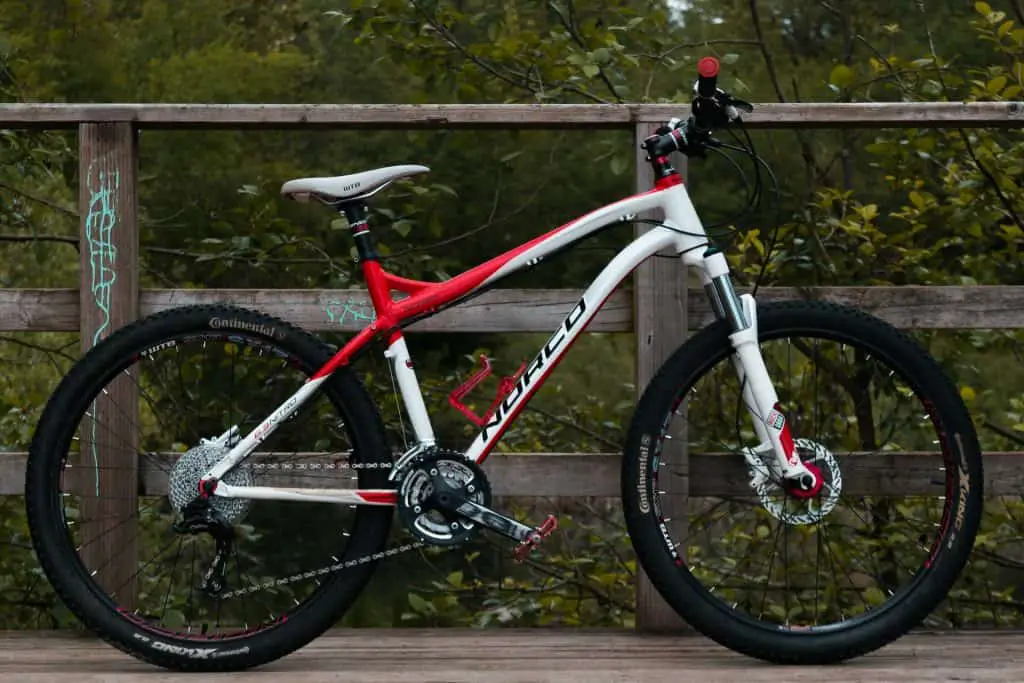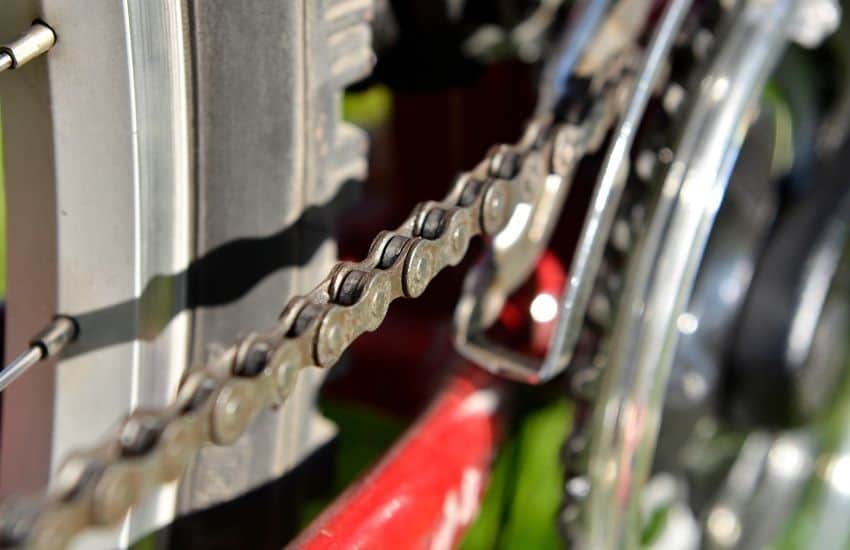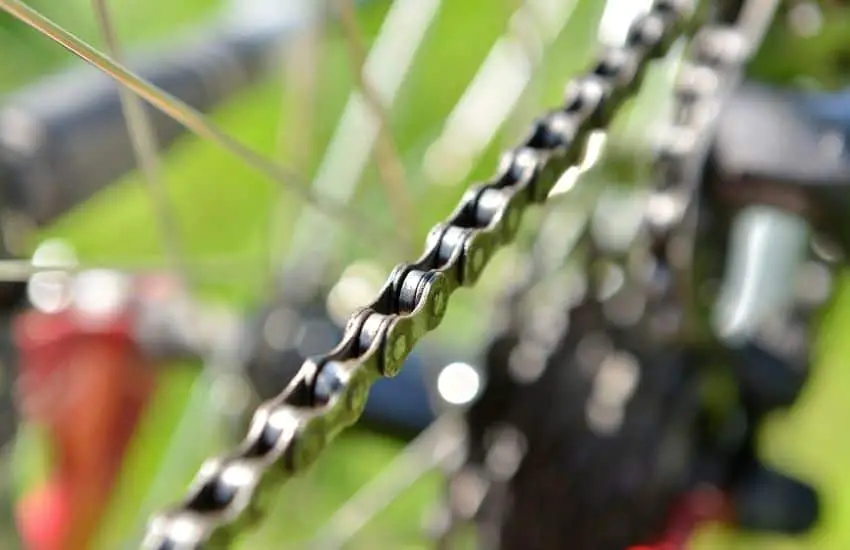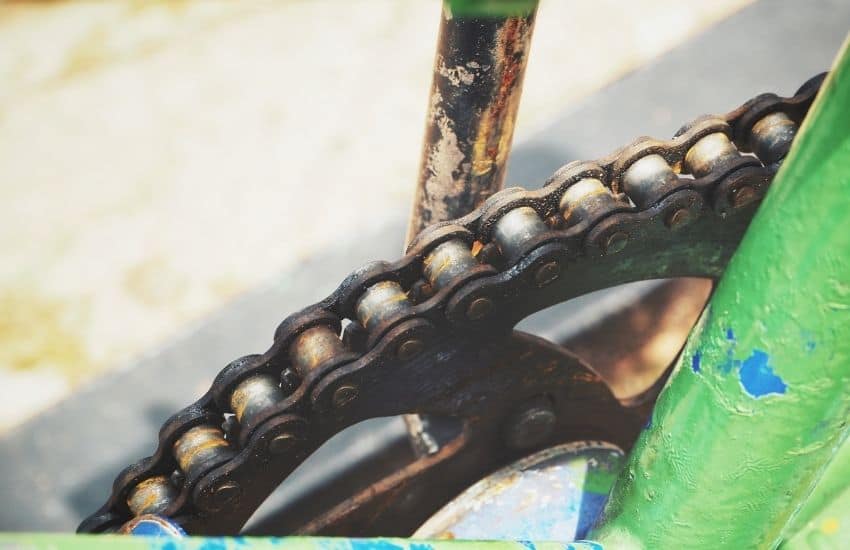You may encounter a bicycle chain skipping over cogs for multiple reasons. It’s inconvenient and kind of frustrating when you’re in the middle of a ride, understanding why this happens can prevent it from interrupting your journey in the future.
In addition to understanding the why, you must know which part is responsible for it. This will allow you to find a solution to the problem much quicker. Although there are many reasons why your bike chain might skip, the solution to most of these problems is simple and inexpensive.
This article will explain the reasons behind bike chain skips when pedaling hard and the solutions to them.
Bicycle Chain Skips Gears
There are two ways a bike chain may skip. The more common occurrence is bike chain skipping gears. Surprisingly, this is a common problem, and there are several reasons it might happen to you.
Typically, what happens is that after you change gears, the chain appears to shift onto the next cog, but it skips in between the two gears. Problems with gear skipping are associated with a derailleur, which can be identified while shifting.
In some situations, gear skipping is not a result of a bad derailleur fitting but an improper chainline. Due to this, the chain comes off the bigger cogs when we try to pedal backward.

You may like, How Long Do Bike Tires Last and When to Replace A Bike Tire?
Common Issues with Chain Skipping Gears
Here are some of the possible reasons why your bike chain is skipping gears:
Bad Cable Adjustment
Even a little bit of stretching in shifter cables can mess with your derailleur adjustment. According to my experience, even the best cables experience a little bit of stretching as time passes.
At times, with lower quality cables, you might experience enough stretching for one full gear. In most cases, you might miss a gear if the cable is expanded far beyond its actual size or the chain is unsuccessful in its attempts to shift to another gear. This makes the bike hard to ride due to skipping on the cog.
To solve this issue, re-align the cable by shifting on to the lowest cog and then fine-tuning the cable tension till it shifts to 2nd cog without any problems.
You can make the shifting better by further making sure the chain is parallel to the cogs alongside it to provide a smooth shifting experience.
Finally, check your limit screws. They are responsible for blocking the derailleur from drawing the chain off the cogs at each cassette’s end on a bike. Loose limit screws can result in a tangled chain and a destroyed derailleur.
Read, Where to Put Bike Lock While Riding.
Stuck Cables
In some situations, regulating cable tension will not do anything. There are several reasons for this: the cables getting jammed or facing trouble moving within the cable housing.
You will often find cables and housing getting rusty after a while. What I do is pull them out now and then and lubricate them with chain oil. This will ensure that the cables do not get stuck anywhere if the oiling is done regularly.
If the oiling does not help, it is recommended that you replace your cables or housing immediately.
Bent Derailleur
Another problem that people face quite commonly is a bent derailleur or derailleur hanger. However, derailleur hangers are constructed in a way that makes them bent frequently. This is done to protect the derailleur itself from receiving any stress or harm.
You cannot fix a bent derailleur, especially if you are aiming for perfect shifting. The only way out is to get a new derailleur. But you can fix a derailleur hanger or a bike frame dropout using derailleur hanger alignment tools which restore them to perfect working condition.
The only negative is that repeatedly doing so on one hanger will make it weak, and as a result, it will bend much easier.
Read, What Is a Cyclocross bike and Why You Should Buy One!
Bent Teeth on Cogs
Bent teeth or cogs may result in a chain skipping gears. What happens is that the chain comes away from the derailleur and causes the gear change. Sometimes, even when the gears do not shift completely, the chain can get removed from the teeth and skip them.
Sadly, you cannot straighten out bent teeth and bent cogs in a manner that makes them usable again. You can straighten only the low-cost steel chainrings with enough force applied to make them work again.
This is because they have enough space between each cog that does not let the chain interfere with the cog alongside it.
>> Buy Bike Chain Repair Kit <<
Improper Chainline
Bikes now have boost components which bring some problems for the chainline as well. The boost technology widens the specific points on the bike supporting the most weight, such as the wheel hubs.
Apart from that, these are pressure points for taking on the most beating when you ride your bike around.
To make things more understandable, if the components on a boost bike are not configured properly, you may find yourself having a bike with a bad chainline. This can lead to gear skipping or the chain skipping over teeth as they cannot hold a chain at a wide angle.
Some people might make the mistake of not getting compatible components when shopping for new components. For this, I recommend people to go on the manufacturer’s website to check component details.
Drivetrain-specific components will provide chainline details that would let you know whether the parts fit your drivetrain or not.
Read, What To Look For When Buying A Used Bike?
Bicycle Chain Skips over Teeth
The larger issue is when you experience your bicycle chain skipping over teeth. Simply put, the chain is unable to sit properly on the cog. This causes the bike chain to skip when pedaling hard.
You might experience this when going on climbs when your chain is the most tightened. The pedals will drop when pushed, and it will make it hard for you to go uphill. It might even hurt you or make you fall off the bike.
Check out, Hardtail vs. Full Suspension
Issues Concerning Bicycle Chain Skipping Over Teeth
Here are some of the reasons why the chain skips over the teeth in a chainring:
Worn Our Chain
In some cases, the chain is just worn out and needs to be replaced. Many cyclists do not even realize that their chains are near the end of their lifetime. In this case, it is better to consult a mechanic who works with bikes regularly.
Let me give you a little insight into how a chain gets worn out. A chain possesses circle links that rotate over the chainring, which has metal teeth itself. The metal on the chainring grinds away at the chain-link slowly, making each link stretch a tiny bit.
Add the hundreds of links on a bike chain, and you end up with an inch of extra chain length. This causes the chain to sit loosely on the chainring. Therefore, when you pedal hard, the chain cannot lock onto the teeth and skips over them instead.
You can use tools to check the health of your chain. One such tool is the Park Tool Chain Checker, which allows you to measure your chain length.
It is beneficial to measure your chain length regularly because when a chain starts to skip, it has already damaged your chainring quite a bit, in which case you might need to get a new chainring as well.
You can slow down the wearing process for the chain by keeping it clean and lubricated. Also, ensure that your bike is kept in dry settings, preventing the chain from rusting
You may like, Can An Electric Bike Replace A Car?
Worn Out Cogs
The cogs take much more time to wear out in comparison to a chain. The deterioration process is like that of chain links, just that now the chain links are eating away the teeth edges. The healthier your chain is, the slower the process of cogs wearing out.
A new chain won’t strain the cogs nearly as much as a chain that has already worn out. A stretched-out chain cannot distribute weight evenly across the teeth of the cogs, making them damaged as a result.
To prevent your chainrings and cogs from wearing out easily, make sure the chain is in good health. In case it is not, look for a replacement promptly.
Stuck Chain-link
A jammed chain link is easy to spot since it mostly happens when the chain is left completely dry and gets rusted as a result.
However, in some instances, it may happen when the chain seems to be working fine. In such cases, the stuck chain link is not caused by rust or lack of cleaning.
Faulty chainplates can lead to your chain getting stuck in the cog. For example, you may be using a chain that has damage on its chainplates from the factory, resulting from a manufacturing defect.
In such cases, a rough edge on a chainplate causes the chain-link associated with it to be stuck in the derailleur pulley whenever it goes over it.
Chains sometimes get damaged while riding. This is particularly true for mountain bikes that deal with gear changes to a bigger chainring while handling all the bodyweight of the rider.
This can cause a chainplate to bend, or worse still; your chain might snap. In a scenario where you deal with a bent chain, the links will require much more effort to move over a healthy chain while causing the chain to skip.
There are numerous ways in which the chain-links on a chain may get stuck. The best way to gauge the condition of your chain-links is to inspect each one using your fingers and see if any of them has any resistance.
Moreover, another problem that uses coincides with the former is your chain being bent. Therefore, you can also check if the chain maintains its original shape or not.
To free stuck chain links, you can use sprays that make the contact points between the metals loosen up. If the chain link is still stuck, you can replace it with a quick link.
This only makes sense if the rest of the chain is relatively new and the remaining parts work fine.
Also you may like to read, Can You Pedal an Electric Bike With a Dead Battery?
Chain Is Too Long
A longer than required chain can lead to chain skipping on bigger cogs. For a derailleur to function properly, it should have a prescribed amount of tension with the chain on the cassette chainrings.
If your bike’s chain is too long, this tension would be lower than needed to sit properly on larger cogs while pedaling hard.
Fortunately, every derailleur brand comes with instructions on what amount of tension is needed for the biggest cog so you can cut your chain in the proper length. There are various tools available on the market which let you cut the chain safely on your own.
Wrong Chain-link Width
The chain-link width affects a chain’s function when people use dissimilar speed chains compared to the gears present on their cassette.
This might be confusing and may have you wondering about why would someone do such a thing? The answer to that is you can sometimes evade the consequences and reap a speed chain’s rewards.
For instance, people may change the whole drivetrain of their bike to another number of cassette gears that may require a new chain. Using the old chain can result in cost savings.
Nevertheless, the old chain may not be compatible with the new cassette gears, which require you to upgrade your chain. It is imperative to ensure that you buy a chain that works with the new cassette drive train in such cases.
Otherwise, an incorrect chain-link width may cause the chain to skip over the chainring or get stuck in it.
Below we have outlined the width of the chain-links required for various configurations of gear settings.
- For a Single-speed chain, you need 1/8″ (3.175 mm)
- For a 5-8 speed chain, you need 3/32″ (2.38 mm)
- For a 9-12 speed chain, you need 11/128 (2.18 mm)
You may conclude that the 5-8 and 9-12 chains are exchangeable from the information above. However, this is not the case due to the different widths of the outer plates.
However, you might be able to use them for different numbers of cassette sprockets despite a few restrictions in some cases.
For instance, you can utilize a slimmer chain where it is not prescribed, such as using a 12-speed chain with 9, 10, or 11-speed cassettes as they are both embody a 3/32″ width inner plate.
In certain situations, you may have to compromise on a little bit of performance unless the derailleur is of high quality resulting in precise shifting.
Unfortunately, you cannot use a 9-speed chain on 10, 11, or 12-speed cassettes since the outer plate of such a chain would be wider, making the chain stuck in the middle of the cassette sprockets and the brake. It would not happen always, but this is most likely the case.
The great thing about chain-link widths is that you can practically use any 9-12 gear setup for single front chainrings constructed for 12-speed drivetrains.
This lets you use a superior quality chain with the front chainrings while saving money on the drivetrain’s remaining components. This enables you to achieve inexpensive drivetrain conversions.

Also, read, How to Determine E-Bike Battery Amp Hours?
Freehub Skipping
Although it is uncommon, you might have a freehub that may be skipping. The complication here is that it is hard to decipher between the problem with a chain and a freehub unless you observe it with your own eyes.
If you can hear sounds as you pedal hard, it becomes apparent that there is a problem with the freehub as the chain does not make these noises.
Freehubs have pawls, letting them turn in one direction while blocking movement in the other direction, retracting as they turn. In older freehubs, the grease gets dried up and rusts the pawls inside a freehub.
This hinders the ability of the freehub to retract properly and block movement in the opposite direction. They could result in the wheel not moving when you try to pedal your bike. However, it will only cause the chain to skip while riding the bike in most instances.
You can try to oil the freehub to resolve the issue, but if you are unsuccessful, it is better to get the freehub replaced. You might have to replace the whole wheel in some scenarios if you cannot find the exact freehub for your wheel.
You may also like:
- What is the Best Electric Bike Repair Stand?
- Can an Electric Bike Get Wet?
- When to Charge an Electric Bike?
Conclusion
It is never fun to experience chain skipping when you are trying to race against your peers or just trying to go up the hill using your mountain bike. To avoid issues related to chain skipping, make sure you service your bike regularly. If you are unable to service the bike on your own, it is better to take help from a professional.

I am Michael, an avid rider and bike expert. I am here to provide, biking tips and expert advice on in-depth bike reviews covering features, capabilities, price range, and much more. Specially on electric bikes, mountain bikes, road bikes, etc. I will provide honest product reviews, along with expert advice on purchasing, training, and maintenance. Check out my complete profile.

